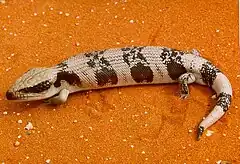| Tiliqua | |||
| Gray, 1825[1] | |||
 Przedstawiciel rodzaju – T. occipitalis | |||
| Systematyka | |||
| Domena | |||
|---|---|---|---|
| Królestwo | |||
| Typ | |||
| Podtyp | |||
| Gromada | |||
| Rząd | |||
| Infrarząd | |||
| Rodzina | |||
| Podrodzina | |||
| Plemię | |||
| Rodzaj |
Tiliqua | ||
| Typ nomenklatoryczny | |||
|
Lacerta scincoides White, 1790 | |||
| Synonimy | |||
|
| |||
| Gatunki | |||
| |||
Tiliqua – rodzaj jaszczurek z podrodziny Lygosominae w obrębie rodzinie scynkowatych (Scincidae).
Zasięg występowania
Rodzaj obejmuje gatunki występujące w Indonezji, Papui-Nowej Gwinei, Yapen, Wyspach Admiralicji, Nowej Brytanii, Archipelagu Bismarcka i Australii[8][9].
Systematyka
Rodzaj zdefiniował w 1825 roku angielski zoolog John Edward Gray w artykule poświęconym rodzajom płazów i gadów wraz z opisem nowych taksonów opublikowanym w czasopiśmie Annals of Philosophy[1]. Gatunkiem typowym jest (oznaczenie monotypowe) scynk olbrzymi (T. scincoides).
Etymologia
- Tiliqua: etymologia nieznana, J.E. Gray nie wyjaśnił pochodzenia nazwy rodzajowej[1]; Louis Agassiz sugerował że jest to zmyślona nazwa[10].
- Trachydosaurus (Trachysaurus): gr. τραχυς trakhus ‘chropowaty, szorstki, najeżony’[11]; σαυρος sauros ‘jaszczurka’[12]. Gatunek typowy (oznaczenie monotypowe): Trachydosaurus rugosus Gray, 1825.
- Cyclodus: gr. κυκλος kuklos ‘okrąg’[13]; οδους odous, οδοντος odontos ‘ząb’[14]. Gatunek typowy (oznaczenie monotypowe): Cyclodus flavigularis Wagler, 1828 (= Scincus gigas Schneider, 1801).
- Brachydactylus: gr. βραχυς brakhus ‘krótki’[15]; δακτυλος daktulos ‘palec’[16]. Gatunek typowy (oznaczenie monotypowe): Brachydactylus typicus Smith, 1834 (= Trachydosaurus rugosus Gray, 1825).
- Rachites: gr. ῥαχιτης rakhitēs ‘kręgosłupowy’, od ῥαχις rakhis ‘kręgosłup’[17].
- Silubolepis: gr. σιλλυβον sillubon ‘gatunek ostu’[18]; λεπις lepis, λεπιδος lepidos ‘łuska, płytka’, od λεπω lepō ‘łuszczyć’[19].
Podział systematyczny
Do rodzaju należą następujące gatunki[8]:
- Tiliqua adelaidensis (Peters, 1863) – lazurnik karłowaty[20]
- Tiliqua gigas (Schneider, 1801)
- Tiliqua multifasciata Sternfeld, 1919 – lazurnik środkowoaustralijski[20]
- Tiliqua nigrolutea (Quoy & Gaimard, 1824)
- Tiliqua occipitalis (Peters, 1863)
- Tiliqua rugosa (Gray, 1825) – lazurnik krótkoogonowy[20]
- Tiliqua scincoides (White, 1790) – scynk olbrzymi[21]
Uwagi
- 1 2 Nieuzasadniona poprawka Trachydosaurus Gray, 1825.
- 1 2 Nomen nudum.
Przypisy
- 1 2 3 4 J.E. Gray. A Synopsis of the genera of Reptiles and Amphibia, with a description of some new species. „Annals of Philosophy”. New Series. 10, s. 201, 1825. (ang.).
- ↑ J.E. Gray: Appendix. Containing a list and description of the subjects of natural history collected during Captain King’s survey of the Intertropical and Western Coasts of Australia. W: P.P. King: Narrative of a survey of the intertropical and western coasts of Australia performed between the years 1818 and 1822. Cz. 2. London: John Murray, 1827, s. 430. (ang.).
- ↑ J.G. Wagler: Descriptiones et icones amphibiorum. Monachii, Stuttgartiae et Tubingae: Sumtibus J.G. Cottae, 1828, s. ryc. vi i tekst. (łac.).
- ↑ A. Smith. Descriptions of Trichophorus flaviventris, Halcyon Swainsonii, H. senegaloides, Edolius Ludwigii, lamportornis rufiventris, and a new saurian (Brachydactylus typicus) from Swan River. „South African quarterly journal”. 2 (2), s. 144, 1834. (ang.).
- ↑ A.M.C. Duméril. Rapport sur un ouvrage manuscrit de M. le docteur Cocteau, ayant pour titre : Tabulæ synopticæ Scincoideorum. „Comptes rendus hebdomadaires des séances de l’Académie des Sciences”. 4, s. 16, 1837. (fr.).
- ↑ J.E. Gray. Catalogue of the slender-tongued saurians, with descriptions of many new genera and species. (continued). „Annals of natural history”. 2 (10), s. 228, 1838. (ang.).
- ↑ A.M.C. Duméril & G. Bibron: Erpétologie générale, ou, Histoire naturelle complète des reptiles. T. 5. Paris: Roret, 1839, s. 754. (fr.).
- 1 2 P. Uetz & J. Hallermann: Genus: Tiliqua. The Reptile Database. [dostęp 2024-01-28]. (ang.).
- ↑ R. Midtgaard: Tiliqua. RepFocus. [dostęp 2024-01-28]. (ang.).
- ↑ Reptilia. W: L. Agassiz: Nomenclator zoologicus, continens nomina systematica generum animalium tam viventium quam fossilium, secundum ordinem alphabeticum disposita, adjectis auctoribus, libris, in quibus reperiuntur, anno editionis, etymologia et familiis, ad quas pertinent, in singulis classibus. Soloduri: Jent et Gassmann, 1842–1846, s. 45. (łac.).
- ↑ Jaeger 1959 ↓, s. 269.
- ↑ Jaeger 1959 ↓, s. 229.
- ↑ Jaeger 1959 ↓, s. 73.
- ↑ Jaeger 1959 ↓, s. 171.
- ↑ Jaeger 1959 ↓, s. 38.
- ↑ Jaeger 1959 ↓, s. 75.
- ↑ Jaeger 1959 ↓, s. 220.
- ↑ Jaeger 1959 ↓, s. 238.
- ↑ Jaeger 1959 ↓, s. 139.
- 1 2 3 Praca zbiorowa: Zwierzęta: encyklopedia ilustrowana. Warszawa: Wydawnictwo Naukowe PWN, 2005, s. 384–385. ISBN 83-01-14344-4.
- ↑ W. Juszczyk: Gady i płazy. Wyd. 2. Warszawa: Wiedza Powszechna, 1986, s. 196, seria: Mały słownik zoologiczny. ISBN 83-214-0043-4.
Bibliografia
- E.C. Jaeger: Source-book of biological names and terms. Wyd. 3 (Revised second printing). Springfield: Charles C. Thomas, 1959, s. 1–316. (ang.).
This article is issued from Wikipedia. The text is licensed under Creative Commons - Attribution - Sharealike. Additional terms may apply for the media files.